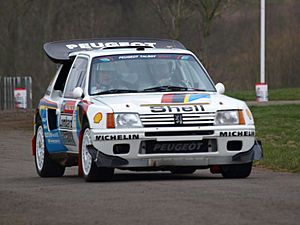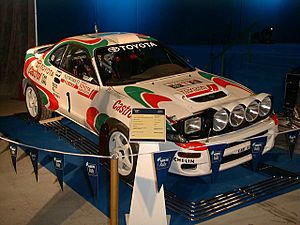Juha Kankkunen facts for kids

Kankkunen in Helsinki in 2006.
|
|
| Personal information | |
|---|---|
| Nationality | |
| Born | 2 April 1959 Laukaa, Finland |
| World Rally Championship record | |
| Active years | 1979, 1982–2002, 2010 |
| Co-driver | |
| Teams | Toyota, Peugeot, Lancia, Ford, Subaru, Hyundai |
| Rallies | 162 |
| Championships | 4 (1986, 1987, 1991, 1993) |
| Rally wins | 23 |
| Podiums | 75 |
| Stage wins | 700 |
| Total points | 1140 |
| First rally | 1979 1000 Lakes Rally |
| First win | 1985 Safari Rally |
| Last win | 1999 Rally Finland |
| Last rally | 2010 Rally Finland |
Juha Kankkunen is a famous Finnish former rally driver. He competed in the World Rally Championship from 1983 to 2002. Juha won 23 world rallies and earned four world championship titles.
He was once the record holder for most wins and championships. Later, other drivers like Sébastien Loeb and Sébastien Ogier won more titles. However, Juha was the first driver to win world championships with three different car manufacturers. This was a very special achievement!
Juha started his career with Toyota Team Europe in 1983. He got his first win with them in 1985. His great driving then led him to join Peugeot in 1986. He became the youngest champion in the series at that time.
After Peugeot left the championship, Juha moved to Lancia. He became the first driver to win two titles in a row. He returned to Toyota for a short time, then went back to Lancia. In 1991, he won his third world title.
In 1993, Juha rejoined Toyota and won his fourth championship. After a break, he raced for Ford and then Subaru. He won his last rally in 1999. Before he stopped racing full-time in 2002, he also drove for Hyundai.
Outside of rally racing, Juha also won the Dakar Rally in 1988. He also won the Race of Champions twice. After retiring from rallying, he worked in business and even tried politics. He also set world speed records on ice in a Bentley Continental GT car.
Contents
- Juha's Early Life and Start in Rallying
- Racing with Toyota: First Wins
- Becoming a Champion with Peugeot
- Winning Back-to-Back Titles with Lancia
- Return to Toyota and Other Adventures
- More Championships with Lancia
- Fourth Title with Toyota
- Racing for Ford and Subaru
- Later Career and Other Interests
- Juha's Personal Life
- Juha's World Rally Championship Wins
- See also
Juha's Early Life and Start in Rallying
Juha Kankkunen grew up on his family's farm in Laukaa, Finland. This area was very close to the route of the famous Rally Finland. His father enjoyed rallying and ice racing as a hobby. He taught Juha how to drive on an ice racing track.
Juha started driving cars when he was only seven years old. He even owned his first car by the age of 12! He began competing in rallies in 1978. His first World Rally Championship event was the 1979 1000 Lakes Rally in Finland. He finished 14th in a Ford Escort RS2000.
A friend of his father's, Timo Mäkinen, coached Juha. With financial help from Timo Jouhki, Juha was able to race often. This helped him gain a lot of experience quickly.
Racing with Toyota: First Wins
In 1983, Juha joined Toyota Team Europe, which was Toyota's main rally team. In his first season, he drove a Toyota Celica Twincam Turbo. He finished sixth in the 1000 Lakes Rally.
In 1985, he achieved a big surprise victory at the Safari Rally. He was the first driver ever to win this tough event on his very first try. He then won his second rally in the Rallye Côte d'Ivoire.
Becoming a Champion with Peugeot
Juha's strong performances with Toyota caught the eye of Peugeot. This team was the defending champion. They signed him for the 1986 season. Juha took this chance and won three rallies that year: the Swedish Rally, the Acropolis Rally, and the Rally New Zealand.
The 1986 season ended with some arguments. Rally cars from the "Group B" category were banned for safety reasons. Then, the Peugeot team was removed from the Rallye Sanremo event. Despite these issues, Juha became the youngest champion in the history of the series.
Winning Back-to-Back Titles with Lancia
After Group B cars were banned, Peugeot left the championship. Juha then moved to drive for Lancia Martini. He quickly felt comfortable in the Lancia Delta HF 4WD car. He won the Olympus Rally and the RAC Rally.
This made him the first driver to win the world title two years in a row! Even though he was a champion, he decided to move back to Toyota for the 1988 season.
Return to Toyota and Other Adventures
Juha returned to Toyota Team Europe in 1988. He drove the Toyota Supra Turbo. Toyota also introduced a new car, the Toyota Celica GT-Four ST165. This car had some problems at first.
However, outside of the World Rally Championship, Juha had great success. He won the Dakar Rally on his first try. He also competed in the Pikes Peak International Hillclimb and the first-ever Race of Champions. He became the first "Champion of Champions" at that event.
In 1989, the Toyota car improved a lot. Juha won the Rally Australia and finished third in the championship.
More Championships with Lancia
In 1990, Juha rejoined Lancia. He won in Australia again and finished third in the championship. Lancia also won their fourth manufacturers' title in a row.
The 1991 season was amazing for Juha. He won the Safari Rally, the Acropolis Rally, his home event 1000 Lakes Rally, and the Rally Australia. Before the last rally, he was in a close fight for the championship. By winning the RAC Rally, Juha became the first person to win three world titles. He also set a record for the most points in a single season.
In 1992, Juha finished on the podium in every rally he entered. He won the Rally Portugal. The championship was very close again, but he finished second overall.
Fourth Title with Toyota
After Lancia left the WRC, Juha rejoined Toyota in 1993. He drove the Toyota Celica GT-Four ST185. Even with some changes in his co-drivers, Juha won a record fourth world title. He won five rallies that year, including the Safari Rally, Rally Argentina, Rally Australia, and the RAC Rally.
His win at the RAC Rally was his 20th victory, breaking a record. He also became the second motorsports person to be named the Finnish Sportsman of the Year.
In 1994, Juha started well with a second place and a win in Portugal. He had some bad luck later in the season, including a crash and mechanical problems. He finished third in the championship.
In 1995, Juha was leading the championship with two rallies left. However, his team, Toyota, was found to have illegal parts in their cars. The team was banned for 12 months. Juha and other Toyota drivers lost all their points. The racing organization said the drivers did not know about the illegal parts.
Racing for Ford and Subaru
In 1997, Juha joined the Ford factory team. He helped his teammate Carlos Sainz in the championship fight. He finished second in several rallies, including his home rally in Finland. He lost that race by only seven seconds, which was the closest finish ever for that event.
Juha stayed with Ford in 1998. He finished on the podium seven times. Both Ford and Juha finished fourth in their championships. In 1999, Juha moved to the Subaru team.
With Subaru, Juha won the Rally Argentina and Rally Finland. His win in Argentina was his first in over five years. He won his home event, Rally Finland, which was his last victory in the WRC. He finished fourth in the championship again. The year 2000 was not as successful for him.
Later Career and Other Interests
Juha did not race full-time in 2001. He competed in one rally for the Hyundai team. In 2002, he raced in nine rallies for Hyundai. He finished fifth in the Rally New Zealand, which was the team's best result that year. After the 2002 season, Juha retired from the WRC.
After retiring, Juha thought about going into politics. He ran for the European Parliament in 2004 but did not win a seat. He was also a part-owner of a Finnish airline called Flying Finn.
In 2007, Juha set a new world speed record on ice. He drove his own Bentley Continental GT car on the frozen Gulf of Bothnia in Finland. He reached a top speed of 331 kilometers per hour (205 miles per hour). In 2011, he broke his own record, reaching 330.695 kilometers per hour (205.48 miles per hour) in a different Bentley car.
In 2010, Juha returned to race in the 2010 Rally Finland to celebrate the event's 60th anniversary. He was 51 years old and finished an impressive eighth place.
Juha's Personal Life
Juha Kankkunen lives in Monaco but also spends time at his family farm in Laukaa, Finland. He has a large collection of cars, including six Ferraris. He also owns all four rally cars that he used to win his world championships.
Juha has two sons, Tino and Niko. His father, Pekka, and his brother, Timo, were also rally drivers.
Juha's World Rally Championship Wins
Juha Kankkunen won 23 rallies during his career in the World Rally Championship. Here are his victories:
| Number | Event | Season | Co-driver | Car |
|---|---|---|---|---|
| 1 | 1985 | Fred Gallagher | Toyota Celica TCT | |
| 2 | 1985 | Fred Gallagher | Toyota Celica TCT | |
| 3 | 1986 | Juha Piironen | Peugeot 205 Turbo 16 E2 | |
| 4 | 1986 | Juha Piironen | Peugeot 205 Turbo 16 E2 | |
| 5 | 1986 | Juha Piironen | Peugeot 205 Turbo 16 E2 | |
| 6 | 1987 | Juha Piironen | Lancia Delta HF 4WD | |
| 7 | 1987 | Juha Piironen | Lancia Delta HF 4WD | |
| 8 | 1989 | Juha Piironen | Toyota Celica GT-Four ST165 | |
| 9 | 1990 | Juha Piironen | Lancia Delta Integrale 16V | |
| 10 | 1991 | Juha Piironen | Lancia Delta Integrale 16V | |
| 11 | 1991 | Juha Piironen | Lancia Delta Integrale 16V | |
| 12 | 1991 | Juha Piironen | Lancia Delta Integrale 16V | |
| 13 | 1991 | Juha Piironen | Lancia Delta Integrale 16V | |
| 14 | 1991 | Juha Piironen | Lancia Delta Integrale 16V | |
| 15 | 1992 | Juha Piironen | Lancia Delta HF Integrale | |
| 16 | 1993 | Juha Piironen | Toyota Celica Turbo 4WD | |
| 17 | 1993 | Nicky Grist | Toyota Celica Turbo 4WD | |
| 18 | 1993 | Denis Giraudet | Toyota Celica Turbo 4WD | |
| 19 | 1993 | Nicky Grist | Toyota Celica Turbo 4WD | |
| 20 | 1993 | Nicky Grist | Toyota Celica Turbo 4WD | |
| 21 | 1994 | Nicky Grist | Toyota Celica Turbo 4WD | |
| 22 | 1999 | Juha Repo | Subaru Impreza WRC 99 | |
| 23 | 1999 | Juha Repo | Subaru Impreza WRC 99 |
See also
 In Spanish: Juha Kankkunen para niños
In Spanish: Juha Kankkunen para niños







